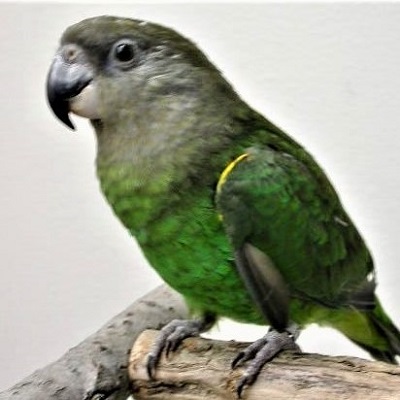
Tomorrow is Halloween, which means the end is nigh…for October, that is. And that also means our Animal of the Month, the brown-headed parrot, is flying out of the spotlight for now. We hope you enjoyed following us on Twitter @ExoticPetVets as we tweeted all month long about these birds with a secret. And if you missed any of our tweets during the month, here is a summary (which also reveals the brown-headed parrot’s secret). Did you know?:
- The brown-headed parrot (Poicephalus cryptoxanthus) is endemic to Africa’s southeastern corridor and has a large range that stretches from South Africa to Kenya.
- In the wild, brown-headed parrots can be found in woodlands and wooded savannas. They can also be found agricultural areas and thornveldts, which are grassland savannas populated mostly with thorny bushes.
- Wild brown-headed parrots like being in tall trees and prefer to be in one of Africa’s most iconic trees – the baobab.
- Many of us enjoyed a Thanksgiving feast this past weekend, but what do brown-headed parrots like to feast on in the wild?
- Brown-headed parrots eat a wide variety of foods in the wild, including flowers, shoots, buds, seeds, nuts, berries and other fruits.
- In parts of their natural range, wild brown-headed parrots are viewed as agricultural pests because they will raid corn and millet fields.
- Social but shy, wild brown-headed parrots are typically found in the tree tops in either pairs or small flocks made up of about a dozen birds.
- If they find an abundant food source, brown-headed parrots can be seen in groups as large as 50 individuals.
- Brown-headed parrots are medium-sized stocky parrots with short tails. Adults reach an average of 9 inches (22 cms) in length.
- The plumage on brown-headed parrots is mostly varying shades of green. As their name suggests, the feathers on their heads are a brown-grey colour.
- Brown-headed parrots have beaks that are two different colours. The lower part (lower mandible) is a whitish-bone colour, but the upper part of the beak (upper mandible) is mostly or entirely dark grey.
- Brown-headed parrots may not seem like the most colourful birds on the surface. But the underside of their wings conceal a surprising splash of colour – bright yellow feathers that can be seen while they’re in flight.
- Observing brown-headed parrots in the wild can be a real challenge. They can be shy and their mostly green plumage makes them experts of camouflage in the tree tops, where they prefer to stay.
- Wild brown-headed parrots can best be seen when they are flying among the trees. That’s because the bright yellow feathers on the underside of their wings make them more visible while in flight.
- They may be parrots, but brown-headed parrots are among the quieter parrot species and can be good companions for people who are sensitive to noise and/or live in apartments or condos.
- While they can mimic sounds, brown-headed parrots are not well known for their ability to mimic human speech and their proficiency at it varies from bird-to-bird. Some of them can say some words and phrases, but others can’t.
- With good care, brown-headed parrots can potentially live up to 30+ years in captivity. But even with proper care, they typically live an average of 15-20 years.

